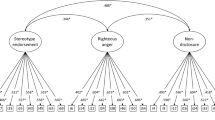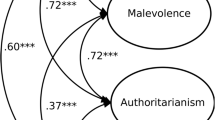Abstract
Aim
Using Link and Phelan’s concept of the stigma process, public attitudes towards people with schizophrenia are examined.
Method
In the spring of 2001, a representative population survey was conducted in Germany (n=5025). A fully structured personal interview was carried out, beginning with the presentation of a case vignette.
Results
Labeling as mental illness increased the likelihood that someone suffering from schizophrenia was considered as being unpredictable and dangerous. This, in turn, led to an increase of the preference for social distance. Although much weaker, labeling also had a positive effect on public attitudes insofar as it was associated with a decrease of the tendency to attribute the responsibility for the occurrence of the disorder to the afflicted person. However, this had no significant impact on the desire for social distance. There was no significant association between labeling and the anticipation of poor prognosis. There were some differences between respondents who are familiar with mental illness and those who are not.
Conclusion
Our findings have some implications for the planning of interventions aimed at reducing stigma and discrimination because of schizophrenia. These interventions should primarily address the stereotypes of unpredictability and dangerousness since they are most likely to have a negative impact on the public’s willingness to engage in social relationships with those suffering from this disorder. The interventions should also be tailored according to whether the target population is familiar with mental illness or not.
Similar content being viewed by others
References
Angermeyer MC, Matschinger H, Corrigan PW (2004) Familiarity with mental illness and social distance from people with schizophrenia and major depression: Testing a model using data from a representative population survey. Schizophr Res 69:175–182
Angermeyer MC, Matschinger H, Grobel S (1995) Einstellung der Bevölkerung zu Alkoholkranken, Teil 1: Soziale Distanz (Attitude of the public towards alcoholics, Part 1: Social distance) Sucht 41:232–237
Angermeyer MC, Matschinger H (1997) Social distance towards the mentally ill: results of representative surveys in the Federal Republic of Germany. Psychol Med 27:131–141
Angermeyer MC (2002) From intuition—to evidence-based antistigma interventions. World Psychiatry 1:21–22
Bogardus ES (1925) Measuring social distance. J Appl Sociol 1–2:216–226
Corrigan PW, Green A, Lundin R, Kubiak MA, Penn DL (2001) Familiarity with and social distance from people who have serious mental illness. Psychiatr Serv 52:953–958
Crisp AH, Gelder MG, Rix S, Meltzer HI, Rowlands OJ (2000) Stigmatisation of people with mental illnesses. Br J Psychiatry 177:4–7
Gifi A (1990) Non-linear Multivariate Analysis. Wiley, Chichester
Hall P, Brockington I, Levings J, Murphy C (1993) A comparison of responses to the mentally ill in two communities. Br J Psychiatry 162:99–108
Hayward P, Bright JA (1997) Stigma and mental illness: a review and critique. J Ment Health 6:345–354
Kraus SJ (1995) Attitudes and the prediction of behavior: a metaanalysis of the empirical literature. Personal Soc Psychol Bull 21:58–75
Link BG, Cullen FT, Frank J, Wozniak JF (1987) The social rejection of former mental patients: Understanding why labels matter. Am J Sociol 92:1461–1500
Link BG, Cullen FT (1983) Reconsidering the social rejection of ex-mental patients: Levels of attitudinal response. Am J Community Psychol 11:261–273
Link BG, Phelan JC, Bresnahan M, Stueve A, Pescosolido BA (1999) Public conceptions of mental illness: Labels, causes, dangerousness, and social distance. Am J Publ Health 89:1328–1333
Link BG, Phelan JC (2001) Conceptualizing stigma. Ann Rev Sociol 27:363–385
Link BG, Struening EL, Rahav M, Phelan JC, Nuttbrock L (1997) On stigma and its consequences: Evidence from a longitudinal study of men with dual diagnoses of mental illness and substance abuse. J Health Soc Behav 38:177–190
Lopez-Ibor Jr JJ (2002) The WPA and the fight against stigma because of mental illness. World Psychiatry 1:30–31
Martin JK, Pescosolido BA, Tuch SA (2000) Of fear and loathing: The role of ‘disturbing behavior’, labels, and causal attributions in shaping public attitudes toward people with mental illness. J Health Soc Behav 41:208–223
McKeon P, Carrick S (1991) Public attitudes to depression: a national survey. Ir J Psychol Med 8:116–121
Ng SL, Martin JL, Romans SE (1995) A community’s attitudes towards the mentally ill. N Z Med J 108:505–508
Penn DL, Guynan K, Daily T, Spaulding WD, Garbin CP, Sullivan M (1994) Dispelling the stigma of schizophrenia: What sort of information is best? Schizophr Bull 20:567–578
Sartorius N (1997) Fighting schizophrenia and stigma: a new WPA educational program. Br J Psychiatry 170:297
Scheff TJ (1975) Labeling madness. Prentice Hall, Englewood Cliffs, NJ
Socall DW, Holtgraves T (1992) Attitudes toward the mentally ill: The effect of label and beliefs. Sociol Quart 33:435–445
Whaley AL (1997) Ethnic and racial differences in perceptions of dangerousness of persons with mental illness. Psychiatr Serv 48:1328–1330
Author information
Authors and Affiliations
Corresponding author
Rights and permissions
About this article
Cite this article
Angermeyer, M.C., Matschinger, H. Labeling—stereotype—discrimination. Soc Psychiat Epidemiol 40, 391–395 (2005). https://doi.org/10.1007/s00127-005-0903-4
Accepted:
Issue Date:
DOI: https://doi.org/10.1007/s00127-005-0903-4




